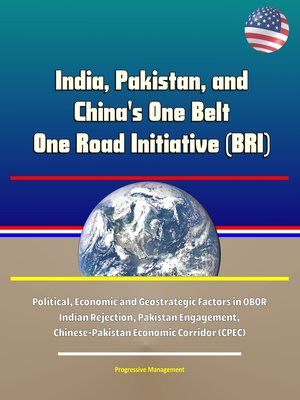India, Pakistan, and China's One Belt One Road Initiative (BRI)--Political, Economic and Geostrategic Factors in OBOR Indian Rejection, Pakistan Engagement, Chinese-Pakistan...
ebook

Sign up to save your library
With an OverDrive account, you can save your favorite libraries for at-a-glance information about availability. Find out more about OverDrive accounts.
Find this title in Libby, the library reading app by OverDrive.



Search for a digital library with this title
Title found at these libraries:
| Library Name | Distance |
|---|---|
| Loading... |
This report has been professionally converted for accurate flowing-text e-book format reproduction. Current academic literature is replete with analyses on the return of great power competition due to China's rise. One area of concern among policy makers has been China's One Belt and One Road Initiative (BRI) and its impact on global security. This thesis examines India and Pakistan's reactions to China's BRI through analysis of political, economic, and geostrategic factors. India's non-support for the BRI stems from the perception that the BRI poses a direct threat to the rules-based international system and its own aspirations to become the South Asian region's dominant power. Conversely, Pakistan supports and has actively engaged in the BRI to counter a growing India and to increase its national power to achieve that end.
This compilation includes a reproduction of the 2019 Worldwide Threat Assessment of the U.S. Intelligence Community.
I. Introduction and Overview * A. Significance of Research * B. Literature Review * 1. India's Economic Explanations * 2. India's Political Explanations * 3. India's Geostrategic Explanations * 4. Pakistan's Economic Explanations * 5. Pakistan's Political Explanations * 6. Pakistan's Geostrategic Explanations * C. Potential Explanations and Hypothesis Evidence * D. Research Design * E. Thesis Overview * II. India and the BRI * A. India's Political Explanations: Maintenance Of U.S.-Led International Rules * B. India's Economic Explanations * C. India's Geostrategic Explanations * D. Conclusion * III. Pakistan and the BRI * A. Overview Of Chinese-Pakistan Economic Corridor (CPEC) * B. Explanatory Factors * 1. Geostrategic * 2. Economic * 3. Political * C. CONCLUSION * IV. Conclusion * A. Overall Findings * 1. Main Ideas * 2. Policy Recommendations
China's BRI, an extensive foreign policy and economic initiative, has already made massive inroads in South Asia. Thus, the BRI has become a symbol of Chinese soft power in the region. China is attempting to advance its positive image in South Asia, spurring regional economic growth by tapping into underdeveloped markets via inter-regional connectivity. As a result, the BRI could open the flow of trade and wealth to member countries. Specifically affecting India are the Chinese-Pakistan Economic Corridor (CPEC), the Bangladesh-China-India-Myanmar (BCIM) corridor, and the Maritime Silk Road Initiative (MSRI). These three economic corridors represent the BRI in South Asia and will eventually be incorporated into the greater BRI enterprise.







